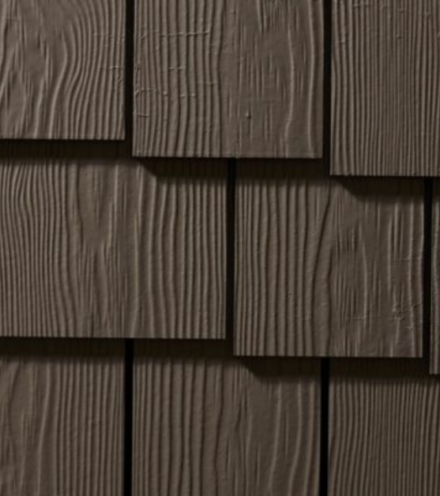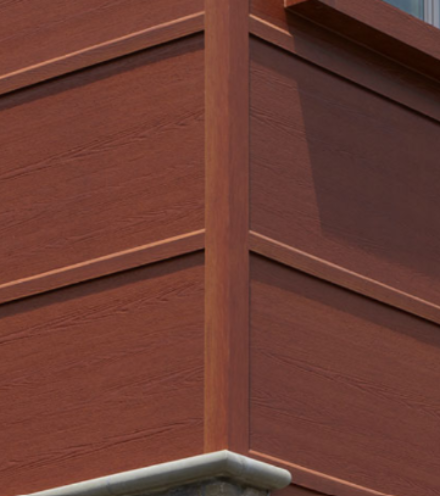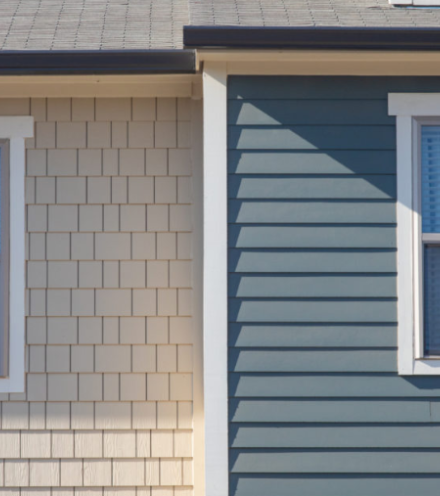
While most types of siding are installed horizontally, there are also several styles that call for a vertical application. Vertical sidings come in many forms from a simple vertical panel to the popular style known as board-and-batten. Vertical sidings draw the eye upward, which can call attention to certain architectural details of a home or make a smaller home look taller. Vertical siding can also create an interesting accent, especially when used on a portion of the home, combined with other sidings or materials.
Fiber cement siding, which is a highly durable and low maintenance alternative to wood, can be used in many vertical siding applications.
The Popularity of Vertical Siding

One type of vertical siding, known as board-and-batten, is one of the oldest types of siding used in the U.S. When sawmills first came to America and people began to cut their logs into planks, most of the wood used to side homes was as much as 12-inches wide and many feet long. The siding was installed vertically, as one plank was often enough at the time to cover the height of a home. The edges where the planks were fitted together were covered with thin strips of wood called battens. The battens helped keep out the elements, making the homes more weathertight. As wood siding became more uniform and frequently used, more styles of siding became available, including other forms of vertical siding, as well as the horizontal lap siding that is still seen today.
Vertical siding like board-and-batten isn’t as common as it once was, but it’s still a popular way of cladding a home. Vertical siding can stand out in a crowd, and often adds a little touch of style that can set a home apart. It can be used in several different applications, all of which can be created using fiber cement siding.
Why Fiber Cement Siding?
Fiber cement siding is a durable, low maintenance alternative to wood. It’s made of a blend of cellulose fiber, Portland cement, sand, and silica. It resists moisture, insects, peeling and chipping, so it can last a lot longer than wood, with less maintenance. It’s also available in a wide range of styles and colors, including many different widths that can be installed in vertical applications. Because the material is easy to work with, as well as highly uniform in shape and size, it can be used to create a wide range of designs, including those that use vertical siding either over the entirety of the facade or as an accent.
Vertical Fiber Cement Siding Design Ideas
If you’ve been considering fiber cement siding for your home, or you’ve been thinking about changing to a vertical siding application, take a look at these 13 designs. These homes all use fiber cement siding, with some form of vertical application as well, so they’ll give you the inspiration you’re looking for to complete your own design.
1. Vertical Backdrop

This home uses a simple vertical siding over the majority of the facade. An irregular shingle siding in a slightly darker color is used as accents. The combination of the darker color and the different siding shape makes them pop out against the simple backdrop. The color and placement of the main siding help give this home a very simple and slightly rustic appeal.
2. Upper Story Board and Batten

This home uses a wide board-and-batten siding on the upper portion, with a traditional lap siding on the lower half. The divide between the two different siding styles adds subtle interest and contrast to the home. The two types of siding are united in color, and the same trim and accent colors are used in both areas as well, so only the change in siding shape and configuration stands out.
3. Board-and-Batten Accent

This home is clad over the majority of the exterior with a horizontal lap siding, and there’s a bump out on the second story that is clad in board-and-batten. This accent calls attention to the slightly different area on the home in a subtle way by maintaining the same color and trim as the rest of the home.
4. Board-and-Batten Emphasis

This home also uses board-and-batten siding to emphasize different parts of the architecture. This home features a lot of different details, and combines horizontal lap siding, board-and-batten, and some architectural panels together in order to make the various sections stand out. They’re all unified by a simple white trim, creating a cohesive design.
5. Bump Out Accent

This simple home features a single bump out on the side. It’s clad in a different siding from the rest of the home, using a vertical board-and-batten while the rest of the facade uses a horizontal lap siding. Both types of siding are done in the same fresh, green color, and both also use the same color trim, so the effect of the bump out is subtle.
6. Allover Board and Batten

This home is made up of different buildings connected to one another. It makes sense that the two buildings would feature the same color for unity, but different styles of siding to add to their distinction. The building on the right features allover board-and-batten siding while the other building is done in a horizontal lap. The contrast between the two adds some depth and character to the property, while the roof styles and color unite them.
7. Dual Accents

This home uses a horizontal lap siding over the majority of the facade. There are two sections, however, that use board-and-batten siding as an accent - one on the section to the left of the porch, and one just below the eaves at the roofline above the porch. The lower section of board-and-batten is further accented by some trim and architectural panels, so it becomes the area that your eye is drawn to first.
8. Simple Design

This classically styled home features a very simple vertical siding over its entirety. The clean lines of the siding complement the lines of the home and the porch columns. The garage and outbuilding are done in a contrasting horizontal lap siding, in the same white color as the home. This creates a cohesive look and lets the house stand out.
9. Mixed Siding Styles

This home is made up of several different components, so it makes sense to use different siding styles. Two of the sections are clad in a vertical board-and-batten style while the other two use a shingle style. All of the buildings are the same color for unity, as well as the same color roofs, but the board-and-batten sections also use a standing seam metal roof that complements the long lines of the siding.
10. Stand Out Accents

This bold blue home makes good use of various types of siding including some vertical board-and-batten. The board-and-batten is on two sections, one above the door and the other on an area just to the right. The area to the right also features some architectural paneling to help show off the windows, adding a little more detail to the facade.
11. Minimal Accent

Sometimes vertical siding is used to pull the eye upward, emphasizing the height of the home. In this case, it also serves as an accent at the very top of the home. A small section of board-and-batten siding is seen just above the center windows, under the roofline. The eye is automatically pulled up, creating a small focal point in the facade.
12. Distinctive Accents

This home also uses board-and-batten vertical siding as an accent just below the roofline, but in two places instead of one. The roofline on the front of the home stands out just a bit from the rest of the facade. The placement of vertical siding in this area helps call extra attention to it, adding some distinction to the design.
13. Dueling Textures

This home makes great use of both vertical siding and a shingle-look siding as well. The two materials are paired together over the home’s entirety, with only a horizontal break between them. This gives the home a lot of interesting texture and a unique personality and character.
Add Interest to Your Home with Vertical Fiber Cement Siding
Fiber cement siding is endlessly versatile, coming in many shapes, sizes, and colors. Using it in a vertical application (with or without other styles of siding) will help your home reach its true potential, along with the lower maintenance and durability you’ve come to associate with fiber cement siding.




